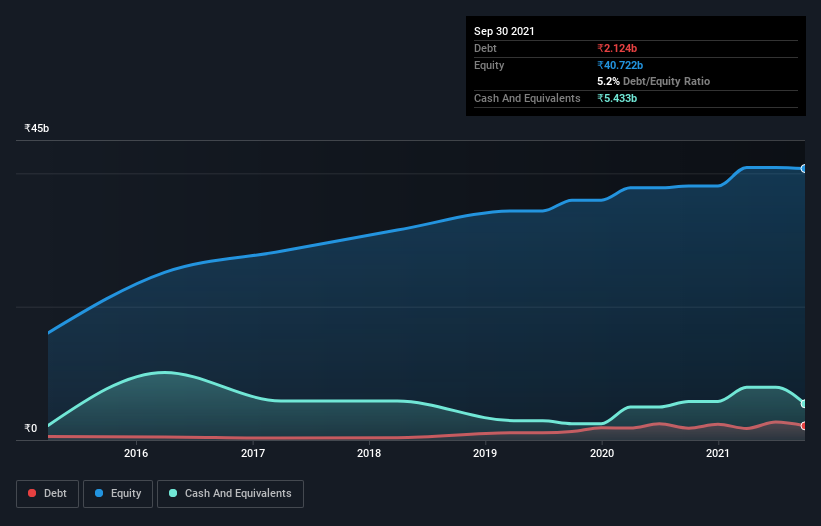Here's Why Kansai Nerolac Paints (NSE:KANSAINER) Can Manage Its Debt Responsibly

Legendary fund manager Li Lu (who Charlie Munger backed) once said, 'The biggest investment risk is not the volatility of prices, but whether you will suffer a permanent loss of capital.' It's only natural to consider a company's balance sheet when you examine how risky it is, since debt is often involved when a business collapses. Importantly, Kansai Nerolac Paints Limited (NSE:KANSAINER) does carry debt. But is this debt a concern to shareholders?
When Is Debt A Problem?
Generally speaking, debt only becomes a real problem when a company can't easily pay it off, either by raising capital or with its own cash flow. Ultimately, if the company can't fulfill its legal obligations to repay debt, shareholders could walk away with nothing. While that is not too common, we often do see indebted companies permanently diluting shareholders because lenders force them to raise capital at a distressed price. By replacing dilution, though, debt can be an extremely good tool for businesses that need capital to invest in growth at high rates of return. The first step when considering a company's debt levels is to consider its cash and debt together.
Check out our latest analysis for Kansai Nerolac Paints
What Is Kansai Nerolac Paints's Debt?
The image below, which you can click on for greater detail, shows that at September 2021 Kansai Nerolac Paints had debt of ₹2.12b, up from ₹1.77b in one year. But it also has ₹5.43b in cash to offset that, meaning it has ₹3.31b net cash.

How Strong Is Kansai Nerolac Paints' Balance Sheet?
According to the last reported balance sheet, Kansai Nerolac Paints had liabilities of ₹14.1b due within 12 months, and liabilities of ₹2.10b due beyond 12 months. On the other hand, it had cash of ₹5.43b and ₹12.1b worth of receivables due within a year. So it actually has ₹1.26b more liquid assets than total liabilities.
Having regard to Kansai Nerolac Paints' size, it seems that its liquid assets are well balanced with its total liabilities. So it's very unlikely that the ₹317.8b company is short on cash, but still worth keeping an eye on the balance sheet. Simply put, the fact that Kansai Nerolac Paints has more cash than debt is arguably a good indication that it can manage its debt safely.
On top of that, Kansai Nerolac Paints grew its EBIT by 33% over the last twelve months, and that growth will make it easier to handle its debt. When analysing debt levels, the balance sheet is the obvious place to start. But ultimately the future profitability of the business will decide if Kansai Nerolac Paints can strengthen its balance sheet over time. So if you're focused on the future you can check out this free report showing analyst profit forecasts.
Finally, a business needs free cash flow to pay off debt; accounting profits just don't cut it. While Kansai Nerolac Paints has net cash on its balance sheet, it's still worth taking a look at its ability to convert earnings before interest and tax (EBIT) to free cash flow, to help us understand how quickly it is building (or eroding) that cash balance. In the last three years, Kansai Nerolac Paints's free cash flow amounted to 30% of its EBIT, less than we'd expect. That weak cash conversion makes it more difficult to handle indebtedness.
Summing up
While we empathize with investors who find debt concerning, you should keep in mind that Kansai Nerolac Paints has net cash of ₹3.31b, as well as more liquid assets than liabilities. And we liked the look of last year's 33% year-on-year EBIT growth. So is Kansai Nerolac Paints's debt a risk? It doesn't seem so to us. The balance sheet is clearly the area to focus on when you are analysing debt. However, not all investment risk resides within the balance sheet - far from it. These risks can be hard to spot. Every company has them, and we've spotted 1 warning sign for Kansai Nerolac Paints you should know about.
Of course, if you're the type of investor who prefers buying stocks without the burden of debt, then don't hesitate to discover our exclusive list of net cash growth stocks, today.
Valuation is complex, but we're here to simplify it.
Discover if Kansai Nerolac Paints might be undervalued or overvalued with our detailed analysis, featuring fair value estimates, potential risks, dividends, insider trades, and its financial condition.
Access Free AnalysisHave feedback on this article? Concerned about the content? Get in touch with us directly. Alternatively, email editorial-team (at) simplywallst.com.
This article by Simply Wall St is general in nature. We provide commentary based on historical data and analyst forecasts only using an unbiased methodology and our articles are not intended to be financial advice. It does not constitute a recommendation to buy or sell any stock, and does not take account of your objectives, or your financial situation. We aim to bring you long-term focused analysis driven by fundamental data. Note that our analysis may not factor in the latest price-sensitive company announcements or qualitative material. Simply Wall St has no position in any stocks mentioned.
About NSEI:KANSAINER
Kansai Nerolac Paints
Manufactures and supplies paints and varnishes, enamels, and lacquers in India.
Flawless balance sheet established dividend payer.
Similar Companies
Market Insights
Community Narratives



